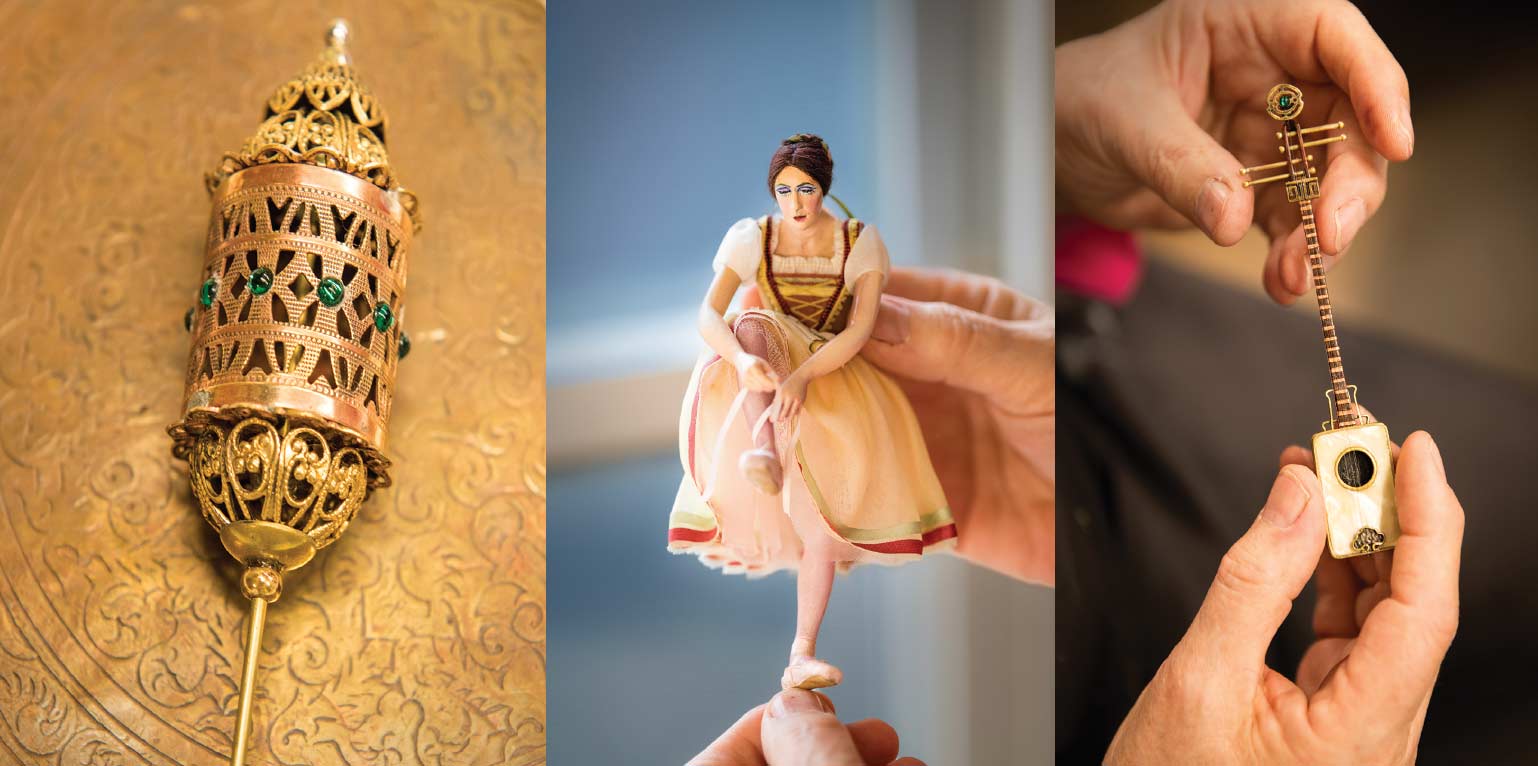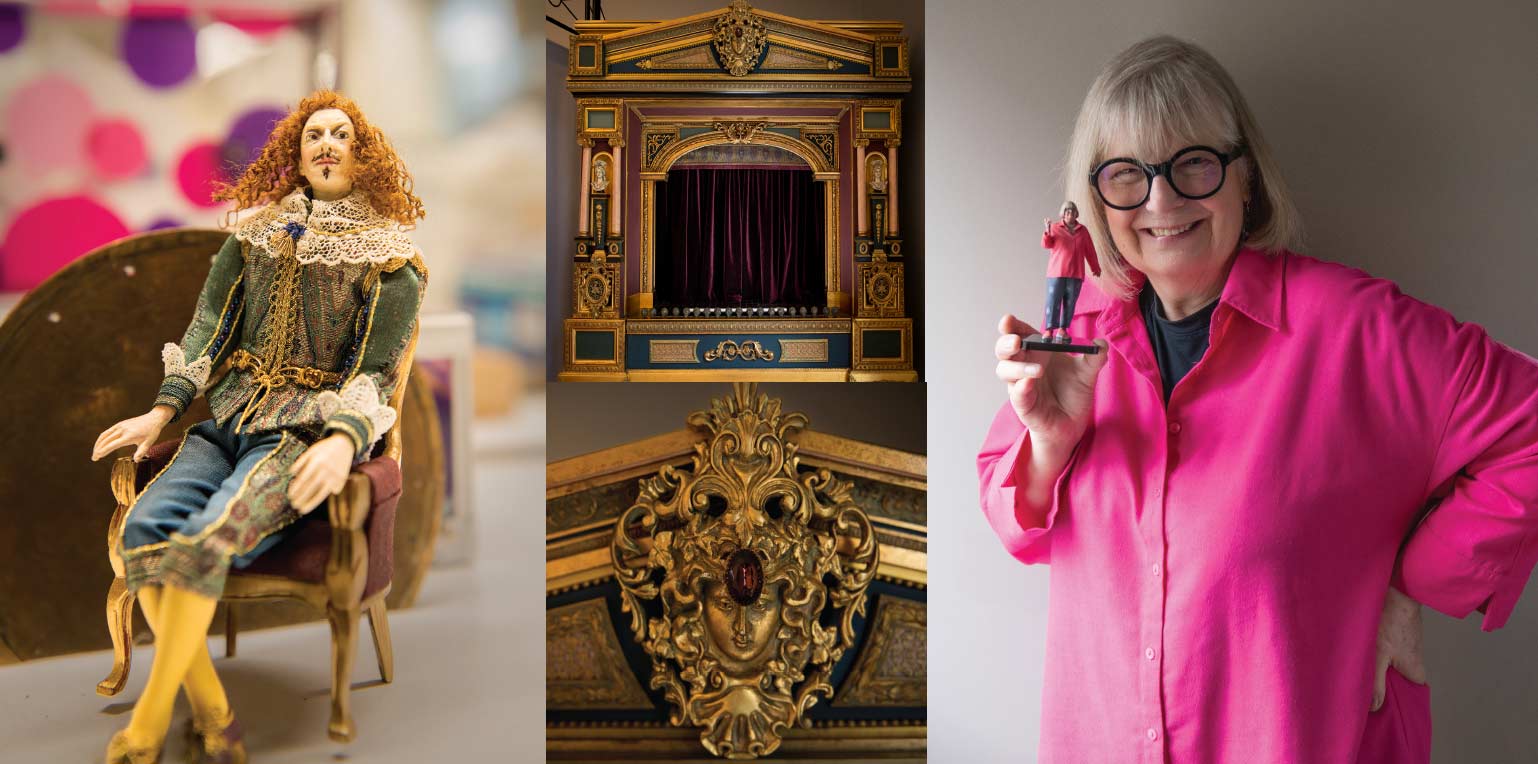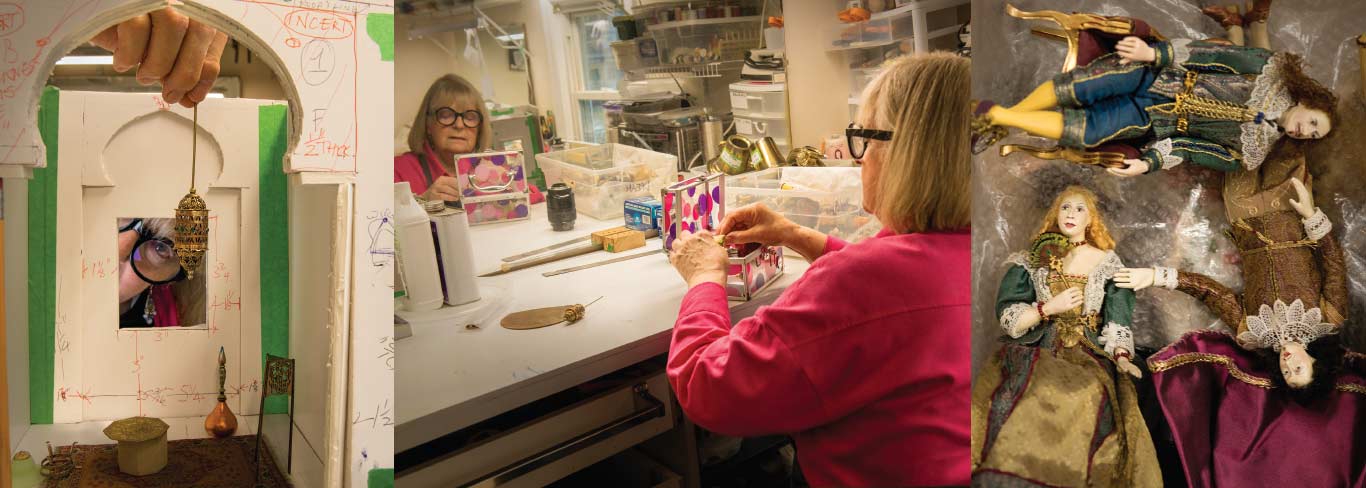


Everything small is big again as interest in miniature modelling grows in popularity. Artist Arline Smith can create a whole world that will fit on your ping pong table.
There she was, 22 years old, on her knees with the actor Ben Kingsley standing inches away in front of her. He was all but naked.
She reached out in the dark and touched his inner thigh. They were backstage at the Royal Shakespeare Theatre in the UK and it was her job to glue a merkin – an ancient pubic wig designed to conceal Kingsley’s most intimate parts – firmly in place. She took a deep breath, prayed that her fingers would not slip, and glued the merkin in place. Arline Smith has dined out on that story for more than half a century. Kingsley went on to star on stage and screen, winning an Academy Award. Smith, who now lives quietly in Port Hope, built an equally interesting if lower profile career.
Now at the other end of her career Arline Smith is floating on a deeper, quieter swell that has given rise to a renewed interest in tiny things.
Now that she’s 77, the spotlight has found her. This year she became the “resident granny,” the oldest contender on the third season of the Canadian television reality show Best in Miniatures. She was one of ten contestants chosen from Canada, the U.S. and the U.K. to make miniature houses, and all that went into them, on TV. The winner would take home ten thousand dollars. From that first day when she wandered onto the set, she was in her element in this newly hot world of miniatures – miniature houses, miniature furniture, miniature animals – all dreamed up and created as the judges hovered. “I never thought I’d win,” she says rather breathlessly. And – spoiler alert – she didn’t; but that was OK. “Just to be chosen was something.”
Creating tiny worlds may not have the same frisson as navigating around Ben Kingsley’s private parts, but this bizarre and increasingly popular realm of miniatures gives plenty of pause for thought, and for Arline Smith, opened windows she never anticipated.
SMALL GOES BIG
“It’s growing again,” said Tom Bishop, the man who started what has become the world’s biggest miniature show in Chicago. Miniature hand-knotted rugs, dinner plates the size of your thumbnail, tiny Tim Horton’s cups, all of them built at a scale of 1:12 – one foot in real life to one inch in the mini life. The Chicago show has ebbed and flowed in the forty years since it began, and now it’s definitely on an upswing. This past year thousands of people pushed their way into three convention rooms. There were more than 250 vendors from 21 countries selling tiny everything. Chicago is not the only miniature mecca. There is a miniature museum in Tucson featuring George Washington’s Mount Vernon estate; there are shows in Atlanta, North Carolina, Toronto and Montreal, with smaller shows in Kingston and Fergus.
And it’s not only doll house furniture and accessories. There are historic buildings such as the Eiffel Tower or St. Paul’s Cathedral, scaled down to sit comfortably on a ping pong table; model railways (the largest is in Hamburg, Germany), complete with tiny perfect handcrafted trestle bridges, mountains and rivers; miniature ships and airplanes; and all manner of dolls; everything meticulously built by men and women all over the world practising their own brand of artistry.
THE JOURNEY
“I’m not really a miniature artist,” maintains Arline Smith from behind her round glasses. But the lady doth protest too much. She is first and foremost a craftswoman with a distinct artistic flair.
Smith was born in England and came of age in Liverpool in the mid-1960s. “Liverpool was the centre of the universe,” she laughs. “There was a film crew on every corner. Back then it was all about the Beatles.” It wasn’t only the music. Everything was exploding. This was the time of Mary Quant and Carnaby Street, clothes were eccentric and full of colour. Smith was swept up. She went to the Liverpool College of Art (John Lennon had been a student there a few years earlier) and relished every moment. “We lived in the best of times. You felt like you could do anything.” The spirit and imagination of the times made young women bold. She rode a high frothy wave. Now at the other end of her career Arline Smith is floating on a deeper, quieter swell that has given rise to a renewed interest in tiny things.
THE HISTORY
The phenomenon of miniatures – scaling down reality – has been around for centuries. The Egyptians made miniature statues to travel with their pharaohs to the afterlife five thousand years ago. There are ancient Chinese and Japanese miniature urns. In the days before photography, Henry VIII commissioned a miniature portrait of the German princess Anne of Cleves before selecting her as wife number four. Then four hundred years ago came doll houses. Originally they were collector’s pieces for well-heeled Europeans to work out their architectural and decorative fantasies; later they were used by mothers in the domestic arts.
Arline Smith began making miniatures back in the 1990s when she made a rococo theatre, complete with footlights, a theatre curtain, delicately carved and decorated pillars and walls. Everything was painted a burnished gold.
Today miniatures are all things to all people. Yes, they are toys for children and adults. Perfect little cars and dump trucks to zoom round the living room; Barbie houses and everything else that makes up the Barbie empire; 3D versions of characters from cartoons and video games; bobble head sports figurines. Both collecting and making miniatures have become obsessive hobbies for the rich and famous. Rod Stewart spent 23 years building a massive vintage American model railway city, distinct in every grimy detail. American actress and comedienne Anna Faris recreates miniature crime scenes, and the late Kirstie Alley made her own doll houses. Then there are the giant miniatures. The Fran Lebowitz/Martin Scorcese TV series Pretend It’s a City, an exaltation of New York, featured the largest architectural model in the world – a model of New York City that includes every building and waterway in the five boroughs. It measures 9,335 square feet and is housed at the Queens Museum of Art.
What is it that has drawn us to miniatures over the centuries? Arline Smith says it comes down to three C’s. “It’s because little things are cute – little dogs, little children, little houses. We can never stay away from cute. And making miniatures fosters our sense of creativity. We all like to make things – bird feeders, food, tiny pieces of furniture. It makes us feel talented. But most of all – particularly during Covid – miniatures gave us some sense of control, when everything in the real world was so out of control.” Examples abound from all ages. On the television program The Crown, the Queen’s private secretary, an austere man who is all about control, re-enacts historic battles with his toy soldiers in his retirement. One woman, after the Barbie movie came out, posted that as a teenager she deployed her tribe of Barbies to hunt down and behead Ken. And a little boy recently told his grandmother that his mother had been muted when his model of Marshall, from Paw Patrol, stole her voice. Control. During the Covid years, miniature making and buying almost equalled the search for the perfect sourdough bread recipe.
MAKING IT
Arline Smith arrived in Canada in 1980, almost on a whim. She was looking for her grandparents and found them in Newfoundland. At the same time she found a place for herself in this country, working for the prop departments in theatres, on film sets and in advertising. She made fake food, weapons, books – anything an actor could carry; she created body parts for the Brad Pitt movie Legends of the Fall and was bivouacked in a swamp in Puerto Rico with alligators and snakes for Jacob’s Ladder, making sure that the movie stars looked suitably decrepit and miserable. When she worked in advertising she had to make a rutabaga that fell from a great height and neither shattered nor bounced, and fake S-shaped tails for cats. Nothing was the same from one day to the next. She even dabbled in forensic anthropology, learning how to reconstruct a face from a skull. Arline Smith is an almost contradictory combination of whimsical and pragmatic. The ideas rise from the whimsical, playful side of her brain, and it’s the pragmatism that gets things done. Throughout most of her career she has had to work to deadline. There is no shilly-shallying around in Arline Smith’s world.
For Smith the miniatures began back in the 1990s, when she made a rococo theatre, complete with footlights, a theatre curtain, delicately carved and decorated pillars and walls. Everything was painted a burnished gold. The Los Angeles Miniature Museum saw that piece and convinced her to sell it to them. Then she was commissioned to do a piece for a collector in Houston. More recently she created a functioning theatre with tiny ballerinas who danced on an oval track to an abbreviated version of Act 2 of the ballet Giselle. It took Smith almost as long to edit the music as it did to make the theatre.
Houses or furniture move from sketch to something more real when Arline Smith does a first build out of foam core. There is a lot of trial and error.
FROM SKETCH TO 3D
These days Smith can be found most mornings nursing a coffee in the window seat of The Main in Port Hope. In all likelihood she will have pulled her sketchbook out of her pink backpack and will be doodling. Tucked in the book are tiny bits of material, splashes of colour. At home she has a large plastic tub full of this and that: tiny bits of metal that can serve as railings; men’s ties she has picked up at second-hand stores (“Nothing beats ties for interesting designs and silk fabric”); shiny, concave bottoms of soft drink cans that can be recruited to serve as mirrors in tiny houses.
Gradually the sketches take on a third dimension. She has made miniatures of the characters from Shakespeare’s A Midsummer Night’s Dream, beginning by carving them from modeller’s wax. Houses or furniture move from sketch to something more real when she does a first build out of foam core. There is a lot of trial and error. The wax figures are eventually enveloped in a mould and then cast in resin, painted and clothed. Tweezers, fine brushes, magnifiers and bright light come out. It’s delicate, painstaking work. These days there is increasing use of technology such as 3D printing to speed things up. For Smith, an old-school artist, that’s OK as long as the technology is acknowledged. When it’s not, for her there’s an ethical dilemma. Who made the piece – you or the machine? The idea may have sprung from the artist, but it’s not been marinated in personal creative juices. It’s not only that 3D printing and scanning is too easy, but Smith has found that a literal scaling down often just doesn’t “look right. People presume … just reduce the size. That doesn’t work. You have to look and trim. Knowing when and where to reduce and enlarge is the artistry.” To create the image that she wants she often distorts the proportions – makes the head or the hands a little bigger, shifts an angle on a building. That’s what makes a piece her own.
Detail and fine workmanship characterize Smith’s pieces, which is not to say she doesn’t appreciate other styles. “It’s quality and quirkiness that counts,” she says. Strange little paper plates, things made out of cardboard – these too are reflections of a maker’s creativity. And while much of miniaturism is fantasy recreation – building a miniature house that you could never afford full-size – there are now dystopian miniatures. Elliott, the tattoo artist from England who won Season 3 of Best in Miniatures, gravitates to horror and is inspired by urban decay. His winning miniature was the creepy, cobweb-infested, yet perfectly constructed home of a mad scientist.
THE TV SHOW
The Best in Miniatures competition was harder work than it seems in the streamlined sixty-minute TV version. Being chosen was as much about the artist as the work. She submitted photographs of her work and a personal video and after a month or so was summoned for an interview and screened, like all contestants, by a psychologist. Once it began, all the contestants were installed in a Toronto hotel, picked up at 7:00 a.m., taken to the studio and brought back twelve hours later. “It was fun but tough. Twelve hours of standing isn’t easy.” She came away pleased with herself for not being the first to be knocked out, and with a new group of friends. They stay in touch, have done podcasts together, and many of the group went to Las Vegas for that city’s miniature show last February. This summer Arline Smith is off for a week at the International Guild of Miniature Artisans school in Maine – a whole herd of miniature artists working in wood or clay, honing their skills, exchanging tricks of the trade.
There she is, tinkering away with new projects, a woman reinvigorated, with a whole new group of friends, all of them more than 20 years younger. “I feel so young,” she says and laughs at herself. Not a bad way to bookend a career.
Story by:
Karin Wells
Photography by:
Peg McCarthy



